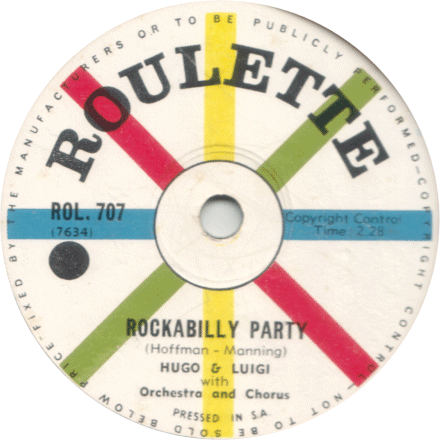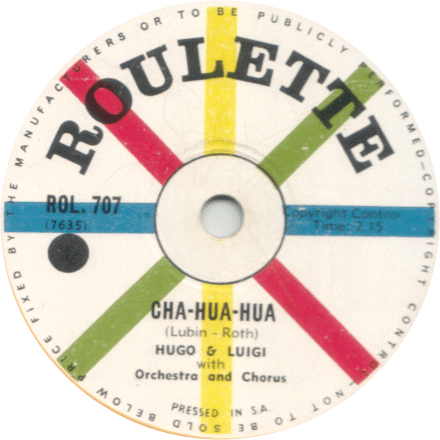
The Beatles
at 78 RPM
|
Cool 78 of the Month July 2009 |
||
|
Hugo and Luigi with Orchestra and Chorus Rockabilly Party Roulette ROL.707 (South Africa) 1958 |
||

|
||
|
In the same way that Wall Street in New York City serves as the financial centre of the world, Broadway has been the focal point for entertainment. The Brill Building at 1619 Broadway is the music business' New York Stock Exchange. Music publishers and composers in residence there from Billy Rose through to Carole King shaped the sound of popular music from the swing era right up to the British Invasion. The songs that came from there were so influential on pop music, that they soon became indentified as a genre unto themselves, The Brill Building Sound. Directly connected to that sound were the great teams of Gerry Goffin and Carole King, Ellie Greenwich and Jeff Barry, Barry Mann and Cynthia Weil, Burt Bacharach and Hal David, and Neil Sedaka and Howard Greenfield. While the hits may have diminished when the Beatles hit the shores of the USA, the influence of these men and women who slaved over a hot piano all day is still felt not only because of their songs, but as a resukt of their work as performers and producers in their own right. One of the longest lasting teams who shared off ice space in the Brill Bulding was that of cousins Luigi Creatore and Hugo Peretti. From the 50s to the 80s, Hugo and Luigi not only produced stars as different as Perry Como and The Isley Brothers, they co-wrote some of the greatest hits of the 50s, co-owned Roulette Records, and gave us a dance craze known as The Hustle. Along the way, they even found time to put out a few records of their own. One of them, Rockabilly Party, could serve as a catalog of the mix of offerings from the offices at Brill Building.
Of the pair, New York City native Hugo was the accomplished musician. As a teenager he played trumpet at various resorts in what was known as the Borscht Belt, the resorts in the Catskills Mountains of New York state. Before long he was a member of various orchestras that accompanied Broadway shows. Luigi on the other hand was a writer. It was his skills with a pen that would bring them together. Hugo's wife was also a writer, albeit of children's books. Had the partnership taken a different path, the productions of Creatore and Peretti would have been literary in nature as Hugo asked Luigi to help his wife with some stories. As it turned out, the music ruled, and their first work was for the Peter Pan label of kiddy records. The pay wasn't great, there were no royalties, just a flat fee per song, so when Irving Green came along and invited them to produce children's records for Mercury, they jumped at the chance. Through the early part of 1950s they continued in this vein from an office above an automobile showroom on 52nd Street. Their break came when Green fired Mercury's A&R man Richard Hayman. Green asked Hugo and Luigi to step into that role at $75 each a week. Green's $150 investment paid off with the release of The Little Shoemaker by The Gaylords in 1954 (Mercury 70403), which shot to the top of the charts opening the door to hits by the Crew-Cuts, Georgia Gibbs, and Sarah Vaughan. Much of their work was making black music palatable to white audiences and before long Mercury was neck and neck with Dot as leaders in that area. Hugo and Luigi realised this and approached Green for more green. He offered to up their salary by $50 each per week to $125. Reluctantly they accepted, knowing that their career at Mercury would lead to better things. Those better things came in a call in 1957 from Morris Levy at the newly established Roulette Records. They left Mercury and became co-owners of Roulette, a label that would score hits even through the battering and bruising that many independents felt when the British Invasion occurred in the 1960s. Along with them they took an artist that Mercury passed on, resulting in million sellers for Jimmy Rodgers such as "Honeycomb" (# 1) and "Kisses Sweeter Than Wine" (# 3), and one of their own compositions "Oh-Oh I'm Falling in Love Again". Their time at Roulette was short. After just two years, they jumped to RCA Victor. During their tenure at Roulette, just as they had at Mercury, they made a few records of their own. Rockabilly Party and Cha-Hua-Hua were two of the releases credited to them. Although released as separate singles in the USA, in South Africa Roulette placed them back to back upon release in 1958, a year after the release of Rockabilly Party in the USA. Rockabilly Party, though, is not so much a rockabilly record but more a call out of pop music of the time naming names and paying tribute to some of their past work with sly musical puns. If you listen to Rockabilly Party expecting to hear a slap bass and vocals such as those of Roulette stablemate Jimmy Bowen, you'll be disappointed. Rather, imagine Mitch Miller and the Gang presents a who's who of pop artists. In the course of 2 and half minutes they mention:
It should also be mentioned that the credit to Hugo and Luigi is as equally questionable as the association with rockabilly of the artists mentioned. In reality the performers are unknown studio musicians under Hugo and Luigi's direction. In short, it isn't them singing and playing. The B-side, Cha-Hua-Hua is a bit like Tequila by The Champs turned inside out. Sort of. It was a hit in 1958 for The Pets, charting at number 34 in Billboard via the Arwin label. Fellow Brill Building veteran Bill Buchanan, also known as half of the team of Buchanan and Goodman of Flying Saucer break-in record fame, would produce a version released on Gone for Eddie Platt and His Orchestra.
Of course Hugo and Luigi had nothing to do with any of that, as they where busy with a label of their own, Avco, producing a number one hit that proved popular at parties of the 1970s just as rockabilly did at parties in the 1950s. That hit was The Hustle by Van McCoy. By 1979, they looked back on their hustle of 30 years, closed up shop and marked the end of the era of independent record men such as themselves. |
||
|
B Side Hugo and Luigi with Orchestra and Chorus Cha-Hua-Hua |
||

|

